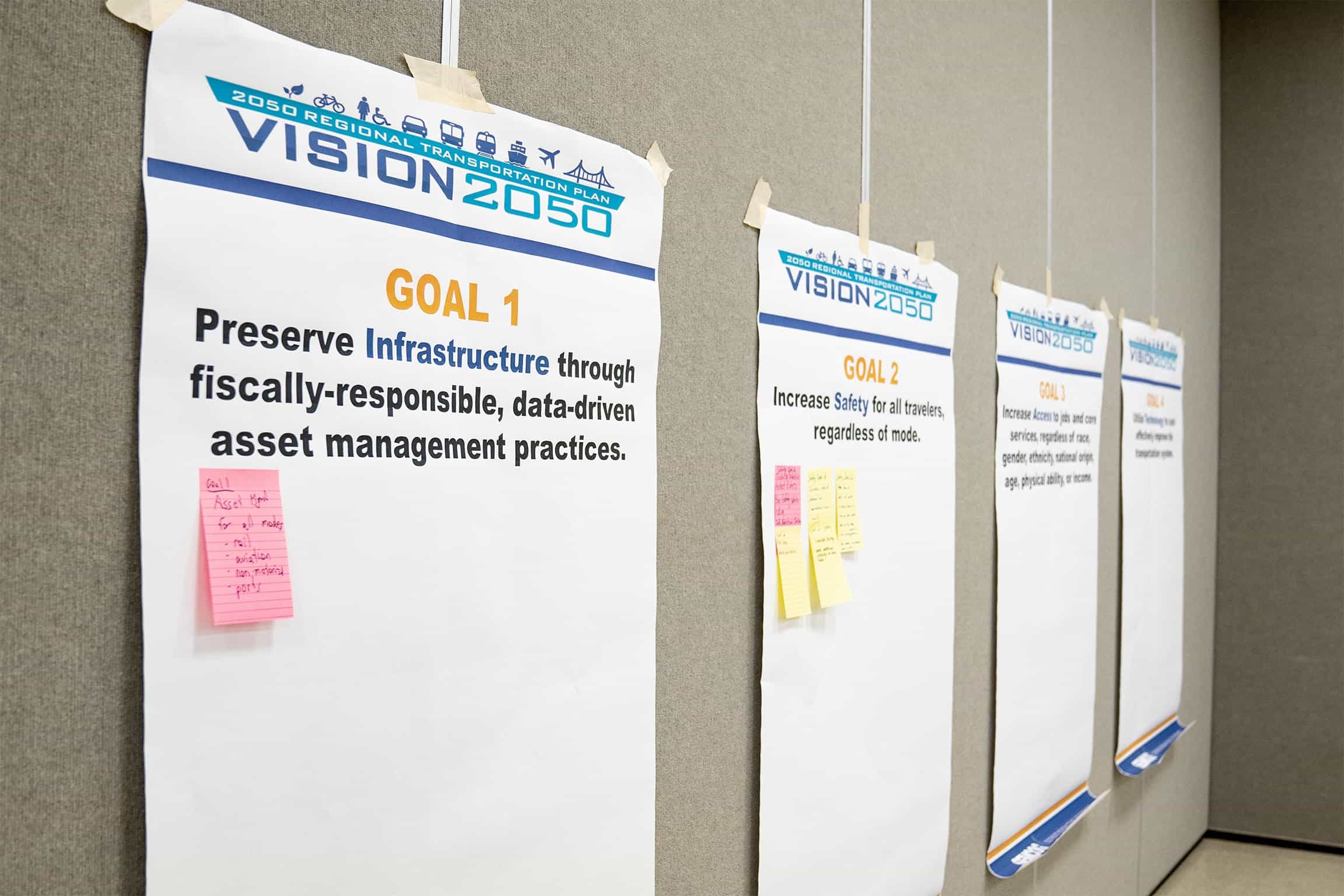Earlier this month, SEMCOG kicked off engagement for Vision 2050, the Regional Transportation Plan for Southeast Michigan, with a series of stakeholder visioning sessions. These three meetings were hosted at community centers in Novi, Gibraltar, and Warren. So first off, a big thank you to these SEMCOG member communities! Your support and partnership are essential to helping us reach as many stakeholders as possible.
Right now, the easiest and best way to support the development of the 2050 Regional Transportation Plan is to complete and share an input survey.

With careful coordination and collaboration between transportation officials, advocacy groups, and the general public, SEMCOG aims to develop a transportation system that enables safe and efficient movement for all, regardless of mode, age, physical or cognitive ability, or socioeconomic status. Thusly, these sessions focused on collecting desired outcomes under the following draft goals for Vision 2050:
- Preserve Infrastructure through fiscally-responsible, data-driven asset management practices.
- Increase Safety for all travelers, regardless of mode.
- Increase Access to jobs and core services, regardless of race, gender, ethnicity, national origin, age, physical ability, or income.
- Utilize Technology to cost-effectively improve the transportation system.
- Integrate Environmental Protection into the transportation system, enhancing community health and increasing the overall resiliency of infrastructure.
- Support the Regional Economy through the reliable movement of goods, efficient trade connections, expanded labor mobility, and support for tourism and local placemaking.
- Educate and Collaborate with local governments, transportation agencies, utility providers, and residents to improve understanding and operation of the transportation system.
- Increase Funding and Expand Local Options to provide resources that are sufficient to meet regional transportation needs.
- Anticipate the Socio-economic Challenges of an Aging Region including sustaining mobility for all ages and mitigating labor shortages.
- Measure Transportation System Performance to facilitate strategic investment through developing, collecting, analyzing, and disseminating data.
Visioning session takeaways

We began each session with an overview of Southeast Michigan’s current regional transportation system and future conditions based on the recently adopted Regional Demographic Forecast. To gather input from stakeholders regarding the vision and goals for the region’s transportation system for the next 25 years, a commonly shared understanding of that system is an important first step.
During group discussions, stakeholders voiced that regional transportation system improvements should be equally shared across populations, regardless of location. SEMCOG supports this view and works to apply a data-driven approach to ensure equitable access to transportation options throughout the region.

Additional takeaways from these discussions include:
- Ensure we are tracking community needs and investments to inform our infrastructure decisions.
- Create maintenance plans to extend the lifespan of infrastructure.
- Improve safety for all modes of travel (including pedestrians, cyclists, and transit users).
- Work with stakeholders to create transportation solutions that cater to everyone, including historically marginalized populations.
- Ensure that diverse communities and users have equal access to technology, including affordability and education, throughout the region.
- Make the transportation system better prepared for extreme weather and climate change.
- Engage communities to understand their transportation needs and concerns for the environment.
- Slow down traffic in busy shopping areas to make them safer for pedestrians.
- Make it easier to travel to economic centers.
- Make transportation connections better between regional economic centers to help goods move around and the economy grow.
- Increase awareness and understanding of the transportation system and how it is maintained and enhanced.
- Get more people involved in planning and decision-making.
- Make the transportation system work better for seniors by making sure they can get to destinations that are important to them.
- Make sure transportation spending matches the goals.
This list represents a relatively small portion of the desired outcomes shared by stakeholders in our visioning sessions, and hearing these perspectives is essential to our process. Based on the data and expertise considered by SEMCOG and our regional planning partners, each of these desired outcomes is consistent with the ten draft goals listed above. Continued engagement will be essential to refine these goals and further specify strategies to achieve desired outcomes.
Next steps

SEMCOG will continue to collect and integrate results and data from further stakeholder engagement to develop objectives to support the ten draft goals. These objectives will be presented during the next round of public meetings, scheduled to begin with in-person meetings on:
These in-person meetings are open to anyone interested in attending, and further information is available on the Vision 2050 website.
Visioning workshops are not the only opportunities for engagement. Everyone can provide input into the draft RTP goals by taking the following survey.
This survey will be open into June and will be used to better develop the next round of visioning workshops scheduled for July. Comments concerning the future transportation system can also be made directly by email.
Thanks to all who contributed their time and expertise, these visioning sessions provided a successful starting point for the update of SEMCOG’s Regional Transportation Plan. The input we heard will be instrumental in developing a transportation system that meets the needs of all Southeast Michigan’s residents, workers, and visitors. Stay tuned for further updates as SEMCOG moves forward with this planning process.

Leave a Reply